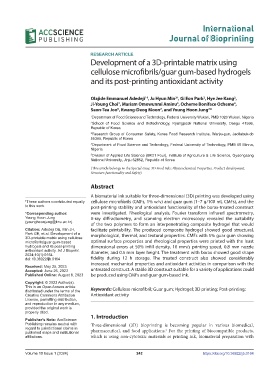Page 250 - IJB-10-1
P. 250
International
Journal of Bioprinting
RESEARCH ARTICLE
Development of a 3D-printable matrix using
cellulose microfibrils/guar gum-based hydrogels
and its post-printing antioxidant activity
Olajide Emmanuel Adedeji , Ju Hyun Min , Gi Eon Park , Hye Jee Kang ,
2†
1†
2
2
Ji-Young Choi , Mariam Omowunmi Aminu , Ocheme Boniface Ocheme ,
2
3
4
Seon-Tea Joo , Kwang-Deog Moon , and Young Hoon Jung *
5
2
2
1 Department of Food Science and Technology, Federal University Wukari, PMB 1020 Wukari, Nigeria
2 School of Food Science and Biotechnology, Kyungpook National University, Daegu 41566,
Republic of Korea
3 Research Group of Consumer Safety, Korea Food Research Institute, Wanju-gun, Jeollabuk-do
55365, Republic of Korea
4 Department of Food Science and Technology, Federal University of Technology, PMB 65 Minna,
Nigeria
5 Division of Applied Life Science (BK21 Four), Institute of Agriculture & Life Science, Gyeongsang
National University, Jinju 52852, Republic of Korea
(This article belongs to the Special Issue: 3D Food Inks: Physicochemical Properties, Product development,
Structure-functionality and Safety)
Abstract
A biomaterial ink suitable for three-dimensional (3D) printing was developed using
† These authors ccontributed equally cellulose microfibrils (CMFs, 1% w/v) and guar gum (1–7 g/100 mL CMFs), and the
to this work. post-printing stability and antioxidant functionality of the borax-treated construct
*Corresponding author: were investigated. Rheological analysis, Fourier transform infrared spectrometry,
Young Hoon Jung X-ray diffractometry, and scanning electron microscopy revealed the suitability
(younghoonjung@knu.ac.kr)
of the two polymers to form an interpenetrating composite hydrogel that would
Citation: Adedeji OE, Min JH, facilitate printability. The produced composite hydrogel showed good structural,
Park GE, et al. Development of a morphological, thermal, and textural properties. CMFs with 5% guar gum showing
3D-printable matrix using cellulose
microfibrils/guar gum-based optimal surface properties and rheological properties were printed with the least
hydrogels and its post-printing dimensional errors at 50% infill density, 10 mm/s printing speed, 0.8 mm nozzle
antioxidant activity. Int J Bioprint. diameter, and 0.5 mm layer height. The treatment with borax showed good shape
2024;10(1):0164.
doi: 10.36922/ijb.0164 fidelity during 12 h storage. The treated construct also showed considerably
increased mechanical properties and antioxidant activities in comparison with the
Received: May 25, 2023
Accepted: June 26, 2023 untreated construct. A stable 3D construct suitable for a variety of applications could
Published Online: August 8, 2023 be produced using CMFs and guar gum-based ink.
Copyright: © 2023 Author(s).
This is an Open Access article
distributed under the terms of the Keywords: Cellulose microfibril; Guar gum; Hydrogel; 3D printing; Post-printing;
Creative Commons Attribution Antioxidant activity
License, permitting distribution,
and reproduction in any medium,
provided the original work is
properly cited.
1. Introduction
Publisher’s Note: AccScience
Publishing remains neutral with Three-dimensional (3D) bioprinting is becoming popular in various biomedical,
regard to jurisdictional claims in 1
published maps and institutional pharmaceutical, and food applications. For the printing of biocompatible products,
affiliations. which is using non-cytotoxic materials as printing ink, biomaterial preparation with
Volume 10 Issue 1 (2024) 242 https://doi.org/10.36922/ijb.0164

